I think investment casting might be right for me, now what?
Helping you to decide whether or not a particular component is a good candidate to be investment cast is what we specialize in. All you need to do is send us a drawing, a 3D CAD drawing file, or even just request a visit from one of our knowledgeable Sales Technicians to discuss your inquiry, and we will do all we can to help you make the RIGHT decision, and offer you our quotation for tools and castings.
Of course, if you already have a part you think would be a perfect candidate to investment cast, here is a quick checklist for several characteristics of the ideal casting which you can go through yourself before sending to us for quoting …
 My part weighs between 0.5 lbs. and 50 lbs., and measures less than 20″ in all directions. Is that a good fit?
My part weighs between 0.5 lbs. and 50 lbs., and measures less than 20″ in all directions. Is that a good fit?
Although we have the capability of casting up to a 200 lb. casting, often 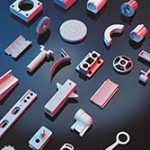 investment castings tend be much lighter and smaller than that, since the larger the casting, the less dimensional accuracy it will retain, the tooling starts to become expensive, and mounting and gating the casting become more challenging. A sand casting is often a better choice in those instances. The opposite is true for smaller components …. the dimensional accuracy of the casting is quite good, the tooling can be produced quite economically, and the mounting and gating can generally be done with little issue, making them ideal candidates for investment casting. For large components where the customer absolutely wants the benefits of the smooth surfaces and internal integrity of an investment casting over a sand casting, it is best when the bulk of the weight should be located in one area, such as the center hub of an impeller or propeller.
investment castings tend be much lighter and smaller than that, since the larger the casting, the less dimensional accuracy it will retain, the tooling starts to become expensive, and mounting and gating the casting become more challenging. A sand casting is often a better choice in those instances. The opposite is true for smaller components …. the dimensional accuracy of the casting is quite good, the tooling can be produced quite economically, and the mounting and gating can generally be done with little issue, making them ideal candidates for investment casting. For large components where the customer absolutely wants the benefits of the smooth surfaces and internal integrity of an investment casting over a sand casting, it is best when the bulk of the weight should be located in one area, such as the center hub of an impeller or propeller.
 The component is something I will need to make more than just once. Is investment casting a suitable option for me?
The component is something I will need to make more than just once. Is investment casting a suitable option for me?
While it may seem over simplistic, an investment casting is best suited 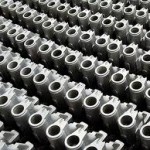 to when the component is required time after time. You have the option of using our prototyping service for sampling, research and development, or very short runs, however the heart of an investment casting is that it is a replica of a wax pattern obtained through using a high precision injection die. The cost of our designing and procuring this tooling for you generally is prohibitive for jobs where a small number of cast components is required only once. Having said this, please remember it is NOT uncommon for our customers to purchase a small lot size of a production casting, sometimes as few as 5 to 25 at a time, since we specialize in, and welcome orders of small to medium run sizes, however our customers generally order these small lots on an ongoing basis.
to when the component is required time after time. You have the option of using our prototyping service for sampling, research and development, or very short runs, however the heart of an investment casting is that it is a replica of a wax pattern obtained through using a high precision injection die. The cost of our designing and procuring this tooling for you generally is prohibitive for jobs where a small number of cast components is required only once. Having said this, please remember it is NOT uncommon for our customers to purchase a small lot size of a production casting, sometimes as few as 5 to 25 at a time, since we specialize in, and welcome orders of small to medium run sizes, however our customers generally order these small lots on an ongoing basis.
 The part I am considering requires a lot of machining on most features and I want to reduce my costs. Can investment casting offer me cost reductions over other processes?
The part I am considering requires a lot of machining on most features and I want to reduce my costs. Can investment casting offer me cost reductions over other processes?
The basic fact when it comes to machining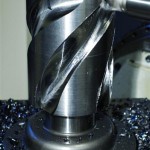 from a solid to manufacture components, is that material is being REMOVED to reveal the geometric properties of your component. Casting on the other hand, takes advantage of the incredible fact that the metal can be worked with in a liquid state, and FLOWED into the geometric shape required. The most distinctive advantages of an investment casting over other processes is the ability to not only form geometries to incredibly tight tolerances, but to cast in those details which typically require substantial machining time to achieve, such as splines, bosses, gear teeth, or any detail. Many, many times, the investment castings inherent tolerance of +/-0.005″ for every inch of dimension means that previously machined details can be cast to size. When tolerances require some finish machining is required, we can leave as much OR as little as you desire on the feature for finishing, substantially cutting down on machining costs and setups required.
from a solid to manufacture components, is that material is being REMOVED to reveal the geometric properties of your component. Casting on the other hand, takes advantage of the incredible fact that the metal can be worked with in a liquid state, and FLOWED into the geometric shape required. The most distinctive advantages of an investment casting over other processes is the ability to not only form geometries to incredibly tight tolerances, but to cast in those details which typically require substantial machining time to achieve, such as splines, bosses, gear teeth, or any detail. Many, many times, the investment castings inherent tolerance of +/-0.005″ for every inch of dimension means that previously machined details can be cast to size. When tolerances require some finish machining is required, we can leave as much OR as little as you desire on the feature for finishing, substantially cutting down on machining costs and setups required.
 The parts I am looking at have very difficult internal details that I can’t form by machining. Will investment casting be an option?
The parts I am looking at have very difficult internal details that I can’t form by machining. Will investment casting be an option?
One of the greatest characteristics 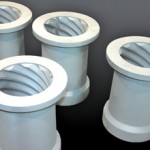 of the investment casting process is that because the “mold” that is formed to receive the molten metal during casting is made from ceramic, which easily breaks away after the casting has solidified and cooled. The internal detail of the wax pattern which was coated to form the ceramic shell can easily be achieved through innovative tooling, soluble wax coring, or ceramic coring. Therefore, there is no limit to the internal detail of a component that can be achieved. In fact, many times an Engineer or Designer not familiar with the flexibility of using investment castings will forego ideal internal details because they feel there is no practical way to produce it other than with costly multiple piece assemblies.
of the investment casting process is that because the “mold” that is formed to receive the molten metal during casting is made from ceramic, which easily breaks away after the casting has solidified and cooled. The internal detail of the wax pattern which was coated to form the ceramic shell can easily be achieved through innovative tooling, soluble wax coring, or ceramic coring. Therefore, there is no limit to the internal detail of a component that can be achieved. In fact, many times an Engineer or Designer not familiar with the flexibility of using investment castings will forego ideal internal details because they feel there is no practical way to produce it other than with costly multiple piece assemblies.
 We use sand castings and forgings now, but we have high costs to finishing the poor surfaces, they need to have draft, and there is inconsistency from part-to-part. Will investment castings be a better option?
We use sand castings and forgings now, but we have high costs to finishing the poor surfaces, they need to have draft, and there is inconsistency from part-to-part. Will investment castings be a better option?
An investment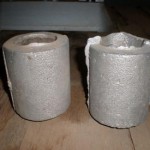 casting should be considered as the premium option when it comes to improving the generally “rough” characteristics of sand castings, forgings, or weldments. Generally slightly more expensive per unit due to the comparatively more involved processing involved, an investment casting has incredibly smooth surfaces and no draft angles or parting lines to deal with when compared to sand castings or forgings, and no weld joints to deal with when compared to a welded assembly. If improving aesthetics of surfaces not finished by machining, removing or reducing machining operations required to finish the more critical features of the part, or even simply having the advantage of castings which will more precisely fit into machining jigs and fixtures, the additional cost of an investment casting is usually MORE than worth it, and should be considered to replace sand castings, forgings, or weldments.
casting should be considered as the premium option when it comes to improving the generally “rough” characteristics of sand castings, forgings, or weldments. Generally slightly more expensive per unit due to the comparatively more involved processing involved, an investment casting has incredibly smooth surfaces and no draft angles or parting lines to deal with when compared to sand castings or forgings, and no weld joints to deal with when compared to a welded assembly. If improving aesthetics of surfaces not finished by machining, removing or reducing machining operations required to finish the more critical features of the part, or even simply having the advantage of castings which will more precisely fit into machining jigs and fixtures, the additional cost of an investment casting is usually MORE than worth it, and should be considered to replace sand castings, forgings, or weldments.
 I am having difficulty finding an ideal raw material stock size for the specialty alloy my parts are made from. Can you cast ANY alloy?
I am having difficulty finding an ideal raw material stock size for the specialty alloy my parts are made from. Can you cast ANY alloy?
One of the most ideal but most 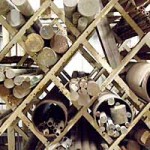 often overlooked benefits of investment casting, is that most any alloy can be melted, and cast, providing a near-net shape component. Investment castings are not restricted to the same generally limited groups of metal alloys found at the metal supermarket. This provides a tremendous convenience and cost saving to the machine shop or weld shop looking for raw material bars, plates, or tubes of the many rare or exotic alloys used today. Not only can we near-net cast your alloy to reduce your finishing costs, we do not require you to purchase a minimum lot size of the alloy before we would consider making the alloy for you. Remember, many times the reason the more suitable but rare alloys that you would like to work with are not available in standard wrought forms, and that is because they are generally very costly because of the high alloy content, or so hard to machine or weld, there is no economic reason to provide the wrought product. With investment castings, the near-net shape provides for minimal up-front material cost, minimal material loss through machining (ie expensive “chips”), and the ability to cast to size many details and dimensions for hard to machine alloys.
often overlooked benefits of investment casting, is that most any alloy can be melted, and cast, providing a near-net shape component. Investment castings are not restricted to the same generally limited groups of metal alloys found at the metal supermarket. This provides a tremendous convenience and cost saving to the machine shop or weld shop looking for raw material bars, plates, or tubes of the many rare or exotic alloys used today. Not only can we near-net cast your alloy to reduce your finishing costs, we do not require you to purchase a minimum lot size of the alloy before we would consider making the alloy for you. Remember, many times the reason the more suitable but rare alloys that you would like to work with are not available in standard wrought forms, and that is because they are generally very costly because of the high alloy content, or so hard to machine or weld, there is no economic reason to provide the wrought product. With investment castings, the near-net shape provides for minimal up-front material cost, minimal material loss through machining (ie expensive “chips”), and the ability to cast to size many details and dimensions for hard to machine alloys.
While rare, there are also some characteristics which are indicative of a component which may NOT be an ideal investment casting candidate. Of course, we encourage you to contact us to be sure for any component you wish to evaluate. Some of those characteristics are as follows :
 – Components which can easily be produced from standard shapes of raw material such as bars, tubes, or angles, especially in common everyday alloys.
– Components which can easily be produced from standard shapes of raw material such as bars, tubes, or angles, especially in common everyday alloys.
– Extremely thin walled components, punch pressed parts, or flimsy long thin parts
– Extremely small, intricate parts (under 0.5″ in size)
– Parts with numerous isolated heavy sections between thin sections (aspect ratios). Redesign with our assistance will usually help resolve.
– We do not offer cast gray or ductile iron, aluminum, titanium, or pure copper alloy parts
– Parts machined on every surface where the IC precision offers no benefit (exception would be where the material is difficult to source as a stock material)
